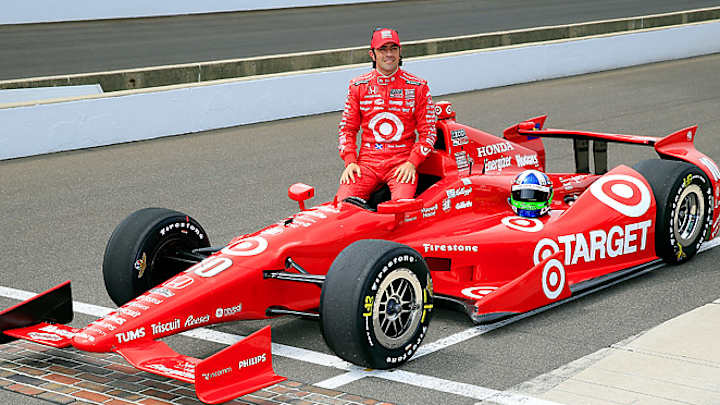Chevy vs. Honda: A closer look at Indy Pole Day qualifying


INDIANAPOLIS -- On Saturday, Carlos Munoz, a 21-year-old from Colombia driving in an IndyCar competition for the first time, qualified in the second starting position for the Indianapolis 500. Meanwhile, Dario Franchitti, a three-time Indy 500 winner and four-time series champion, ended up 17th on Pole Day and will start from the middle of the sixth row.
This seems shocking on the surface. It must mean that Munoz is the best rookie since fellow Colombian Juan Pablo Montoya qualified on the middle of the front row in 2000, right? And that Franchitti must have lost his feel for Indy, right? Wrong on both counts.
Before we get into the engine battles, though, it must be noted that it was a supreme achievement for Ed Carpenter's one-car operation to take the pole at 228.762 miles per hour over the Andretti and Penske cars. Carpenter is a rare owner/driver and his background is also rare in IndyCars, short track oval racing in Midgets, and in Sprint cars. He's been racing in the IndyCar series since 2003 and, not surprisingly, his forte is ovals. Carpenter won the IndyCar finale -- a 500-mile race -- at Auto Club Speedway in Fontana, Calif., a year ago and also has a win at Kentucky Speedway. Carpenter was a contender in last year's 500, driving from the 28th starting spot into the top five before spinning out with 20 laps to go.
But as for the positions for Munoz and Franchitti, this was less about the drivers and more about engine manufacturers and horsepower. Chevrolet took the top 10 positions in qualifying and 13 of the top 15. Certainly give credit to its teams -- Andretti has five cars and Penske three in the top three rows and they're two of the elite IndyCar organizations -- for taking advantage of the power that Chevrolet delivered, but Franchitti drives for the third top-class team in Chip Ganassi Racing.
If this sounds familiar, it is. A year ago during Indy qualifying, Chevrolet teams took eight of the top nine spots on the grid. Honda's lone representative was Josef Newgarden, a rookie driving for Sarah Fisher Hartman Racing and a big surprise.
As for Franchitti? The Scotsman started 16th in 2012. Teammate Scott Dixon was 15th a year ago and he's 16th this year. Dixon has been a contender for the past decade at Indy, winning in 2008 and putting together a string of seven straight top-six finishes. Can you say déjà vu?
One year ago, there was unhappiness, maybe even fear or panic, in the Honda camp after qualifying. But Honda had a plan to sacrifice qualifying to continue to prepare and update race engines. It delivered superior performances and fuel mileage -- a neat trick if you can do it -- and the closing laps of last year's 500 were a duel between Franchitti, Dixon and Honda-powered Takuma Sato, driving for Rahal Letterman Lanigan. Franchitti passed Dixon on the front straight next-to-last lap, Sato also went past on the inside and tried to take the lead. He spun and hit the wall, the caution ending the race, and Franchitti and Dixon delivered a one-two for Honda and Ganassi. Tony Kanaan was the top Chevrolet in third. It was an embarrassment for the bowtie brigade. They'd been ambushed in the biggest race in the world.
Honda seems likely to be following the same game plan as a year ago. Why change? It also seems unlikely that Chevrolet will be surprised again. It might have even seen Saturday coming and was perfectly happy to dominate qualifying, sweep the front row and reap the benefits from a week of valuable positioning. Meanwhile, in Detroit, perhaps its engineers were diligently preparing a counterattack.
It is a 500-mile race and with 33 cars on the track, handling and choosing the correct downforce levels take on greater significance to deal with turbulence in the draft than in qualifying, which is run one car at a time. And then there is execution, the pit stops and strategy. But you also need horsepower, which can trump all in the Indianapolis 500.
Franchitti, Dixon and Sato, who will start 18th in next Sunday's 500, have plenty of laps to get to the front if they get their Dallaras working well. Chances are they will.
On the other hand, Munoz, who drives regularly in the development Firestone Indy Lights Series, is one of Andretti Autosport's five cars and has suddenly emerged as a leading candidate for Rookie of the Year. Nobody could have expected him to start anywhere near the front and now he's in the middle of the front row. Montoya led 167 laps in his 2000 victory, but he was a rookie in status only. He'd been racing regularly in the CART Champ Car Series, which included high speed ovals. Munoz doesn't have any of that experience and he won't be a threat to win the race.
The Andretti team has three other bona fide contenders in Marco Andretti, Ryan Hunter-Reay and James Hinchcliffe.
The competition between Honda and Chevrolet will make for an interesting story line in the week heading into the race and will be a focal point next Sunday. There are careers and advertising budgets at stake in the outcome.
